The Spruce – Heather Zidack and other professionals give their insight on using a humidifier to help keep your Christmas tree fresh.
Tree Care
Chestnuts: A Tasty Thanksgiving Treat
By Dawn Pettinelli, UConn Home & Garden Education Center
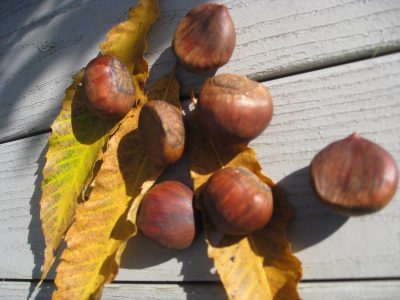
With Thanksgiving approaching, many of us will be sitting down to hearty feasts with family and friends. Time-tested recipes on worn index cards or heavily thumbed cookbooks are combed through/uncovered. Many of us gardeners pick a few new plants for our gardens each year, so why not try a new plant on the dinner table? Chestnuts were reputedly served at the first Thanksgiving and thanks to dedicated breeding programs may be available locally today.
It’s hard to imagine that a little over 125 years ago there were probably 4 billion American chestnuts (Castanea dentata) spread out from southern Maine to northern Georgia. They were an important food source for both indigenous people as well as wildlife. Early European settlers found their rot resistant wood useful for many building purposes.
Unfortunately, a disease (Cryphonectria parasitica), known as chestnut blight, was unintentionally introduced in 1876 on imported Japanese chestnuts (C. crenata). These were sold via mail order throughout the eastern U.S., and our native American chestnuts soon became infected. This fungus spreads by windblown spores. Signs of infection include a reddish-orange ‘rash’ on the affected bark and as it reproduces, an orangey substance oozes from pores in the bark. Cankers form and eventually the plant can no longer internally transport water and nutrients. Chestnut blight kills the parent tree but not the roots so even to this day, you are able to find sprouts growing from chestnut roots. As the sprouts develop, they too will be killed back by the blight so while the tree is kept alive, American chestnuts are considered functionally extinct, but all is not lost.
Fortunately, both researchers and chestnut lovers have been working pretty much for the past 100 years on developing varieties resistant to chestnut blight. Breeding work has been done in many locations but the Connecticut Agricultural Experiment Station began their program in the early 1900s and it is the only program that has continued uninterrupted to this day. Presently this CAES program is led by Forest Pathologist and Ecologist, Dr. Susanna Kerio.
Various chestnut species including American, Chinese Japanese and European have been crossed, backcrossed, planted, evaluated, culled and selected by researchers and enthusiasts all over the eastern U.S. As one can imagine, it takes more time to evaluate a tree’s characteristics than say, an annual plant like a tomato.
Organizations like The American Chestnut Foundation started in 1982 have been championing the search. According to Deni Ranguelova, the New England Regional Science Coordinator, the goal is to develop blight resistant chestnuts and restore this magnificent tree to its native range. Members of this organization have the opportunity to obtain straight species or hybrid seed to try their hand at growing chestnuts and add observations to the chestnut knowledge base.
Why all this work on chestnuts? Well for one, they are deliciously mild and sweet. They are low in calories and high in fiber. Chestnuts are a good source of potassium and other nutrients. Eat them freshly roasted (just like in the song!), in holiday stuffings, soups, in main dishes and glazed. To cook them, they do need to be scored whether oven roasted, boiled, steamed or microwaved to keep them from bursting. Lots of instructions, recipes and videos can be found online.
Second, plants are productive. In fact, it was estimated that before their demise that a mature American chestnut may be able to produce 6000 nuts! They can serve as a food source to both people and wildlife as researchers and enthusiasts create blight resistant strains to plant in our natural areas or in commercial orchards.
Aside from being a member of The American Chestnut Foundation and obtaining seed, one can order chestnut seedlings from several online nurseries. Keep in mind that chestnuts do best in a sunny area with well-drained soil. Root rots can occur in poorly drained areas. Plants are being bred to be straight and tall for timber, or shorter and wider for nut production. Make sure you have enough space for a mature chestnut tree, or most likely 2 trees as chestnuts need another plant for cross pollination.
Even if a chestnut tree is not in your future, do try some chestnut dishes at your Thanksgiving table. They may start a new tradition.
The UConn Home & Garden Education Center supports UConn Extension’s mission by providing answers you can trust with research-based information and resources. For gardening questions, contact us toll-free at (877) 486-6271, visit our website at homegarden.cahnr.uconn.edu, or reach out to your local UConn Extension center at extension.uconn.edu/locations.
This article was published in the Hartford Courant November 15, 2025
Don’t Let Dry Soil Follow Your Plants Into Winter!
By Holly McNamara, UConn Plant Diagnostic Lab
This year, Connecticut’s notably dry summer conditions have continued into fall. According to the U.S. Drought Monitor, all counties are abnormally dry for this time of year, and some are even considered to be in a moderate drought. Thus, many trees, shrubs, and perennials are heading into winter low on moisture. These conditions combined with the dry air, low precipitation, and fluctuating temperatures characteristic of Connecticut winters can lead to plant damage if no supplemental water is provided. Many of your plants will benefit from a deep final soak before the ground freezes.
Fall drought stress often doesn’t show up until spring, or even the following summer.Affected plants may appear perfectly normal and resume growth in the spring, using stored food energy. Plants may be weakened or die in late spring or summer when temperatures rise. Browning evergreens, delayed leaf-out, and sudden dieback are common signs of plants that went into winter too dry.
Moist soil is so important in the fall and winter months because it provides insulation to the roots. It may seem counter-intuitive, but properly hydrated soil does a much better job at protecting roots from freezing temperatures than dry soil. Root damage occurs for this reason when plants do not receive enough late-season moisture.
Woody plants with shallow root systems require the most supplemental water during extended dry periods in the fall and winter. Trees in this category include maples, birches, willows, and dogwoods. This category also includes perennials, and shrubs like hydrangeas, boxwoods, and azaleas. These plants benefit from mulch to further conserve soil moisture and buffer the roots from temperature swings. Apply mulch about 2 to 4 inches away from the trunk all the way to the outermost reach of its branches in a doughnut shape.

Evergreens also benefit from fall and winter watering because they do not go dormant in the winter. Evergreens of any age are still actively respiring during the coldest months of the year and will continuously lose water through their needles. If they go into the winter with dry soil, they are more likely to have a difficult spring recovery. This is especially true for those in open or windy areas.
Only water when daytime temperatures are above 40°F, ideally in the late morning or early afternoon so the water can soak in before possible freezing at night. Feel the soil at a depth of 4 to 6 inches to ensure that supplemental water is necessary. Soil should be consistently moist, but not oversaturated or muddy. Stop supplemental watering after the ground freezes because plants cannot absorb water through frozen soil. To water, use a soaker hose to provide a slow stream of water that can penetrate deeper into the soil with limited runoff. If your hose is already stored away for the winter, and your tree or shrub is small, consider drilling a 1/8-inch hole at the bottom of a 5-gallon bucket and filling that with water for a slow, steady stream. If dry weather continues into the winter and there’s little snow cover, additional watering once or twice a month may be needed until the soil hardens.
A final round of watering now can prevent root injury that won’t be visible until much later. Evergreens, deciduous trees, and other landscape plantings will head into winter stronger with a little extra attention this month. Giving the soil one last watering before it freezes is one of the simplest ways to protect your landscape from winter stress.
The UConn Home & Garden Education Center supports UConn Extension’s mission by providing answers you can trust with research-based information and resources. For gardening questions, contact us toll-free at (877) 486-6271, visit our website at homegarden.cahnr.uconn.edu, or reach out to your local UConn Extension center at extension.uconn.edu/locations.
This article was published in the Hartford Courant October 25, 2025
Spring Landscape and Garden Issues in 2025
By Pamm Cooper, UConn Home & Garden Education Center This spring has been a dramatic one as ornamental trees and shrubs are putting on quite a colorful floral display. Many deciduous ornamentals including redbuds, forsythia, crabapples, fruit trees, quince azaleas and many others were not adversely affected by last summer’s drought and the cold, windy winter and frozen soils that followed. A lesser noticed but significant drama is the negative effect these same environmental conditions had on ornamental and native evergreens.
Rhododendrons and ‘Green Giant’ arborvitae seemed to suffer the most damage followed by cherry laurels and hollies. Last year’s drought conditions that extended into late fall combined with very windy winter conditions and frozen soils were tough for some evergreens. Winter desiccation injury on broadleaved and needled evergreens causes foliage browning when plants cannot take up the water needed to keep foliage healthy. Damage to many rhododendrons and some azaleas could be seen during the winter and is still evident this spring. Buds may provide new leaves by June if branches are still alive.
In contrast, 'Green Giant’ arborvitaes suddenly showed symptoms after warm weather began this spring. This was evident especially in trees on windy sites. Needles are brown or off color and time will tell if they are able to recover. If branch tips are flexible and show new buds, growth may resume. Prune any dead branches that show no signs of recovery.
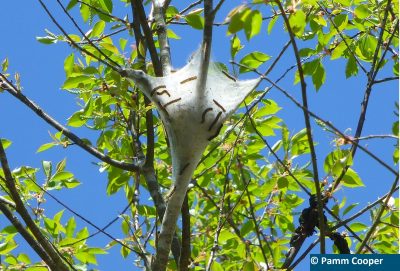
Eastern tent caterpillars have hatched from overwintering egg masses on native black cherries. Silken nests are evident located in crotches of these trees. Caterpillars feed outside the tents at night and hide in them during the day. There is only one generation, and feeding is generally finished by late June. Trees have time to leaf out again to remain healthy during the growing season. Birds like cuckoos and vireos will rip tents apart to feed on the caterpillars.
If you have Oriental lilies, be alert for the lily leaf beetle. This bright red insect can severely defoliate these lilies. Adults overwinter in soil close to the plants they were feeding on the previous season. They appear as soon as lilies begin new growth above the ground. Leaf undersides should be checked for eggs and larvae and crushed when found. Leaves can be treated if needed with a product that larvae will ingest as they feed on the treated leaves. Never spray flowers with any insect control product and always follow directions as written on the product label.
Snowball aphid feeding damage is noticeable on the new leaves of European cranberry bush and snowball viburnums. As the aphids feed on the new leaves and twigs, leaves curl and twigs twist in response to aphid feeding on the sap. Aphids can be found by uncurling the leaves. Treatment is difficult as they are not out in the open where contact control products can reach them. Feeding should end within two months of egg hatch. These aphids overwinter as eggs laid on the branches of host viburnums.
Viburnum leaf beetles, Pyrrhalta viburni, are another significant pest of ornamental and native viburnums. They’re active soon after viburnums leaf out. Damage will be seen as larval populations grow and they skeletonize leaves. Some viburnums may suffer complete defoliation. This pest prefers arrowwood, European cranberry bush or American cranberry bush viburnums. Try switching to resistant varieties such as V. plicatum and Korean spicebush viburnum V. calesii if leaf beetles are a chronic pest.
If anyone has small St John’s wort shrubs or certain weigela cultivars that seem to be dead, wait and see if new growth resumes as it gets warmer and sunnier. The smaller St. Johns’ wort shrubs die back in fall, leaving brown stems with withered fruit. Prune these back almost to the ground as basal growth appears. Some weigela cultivars are just slowly getting started, while others are already full of leaves. Do not give up these plants but wait and see what happens in May.
As always, our UConn Home and Garden Education Center office staff welcomes any questions gardeners may have concerning landscape and garden plants problems. Across the New England region, people are having much the same problems as we are having in Connecticut from the winter weather, but we can hope that plant recovery be swift and complete. Enjoy the growing season and stay alert- scout for pests and other problems before they get out of hand.
The UConn Home & Garden Education Center supports UConn Extension’s mission by providing answers you can trust with research-based information and resources. For gardening questions, contact us toll-free at (877) 486-6271, visit our website at homegarden.cahnr.uconn.edu, or reach out to your local UConn Extension center at cahnr.uconn.edu/extension/locations.
This article was published in the Hartford Courant May 10, 2025
We Asked Arborists When to Prune Dogwood Trees
We Asked Arborists When to Prune Dogwood Trees, and They All Said the Same Thing
The Spruce – Heather Zidack and other professionals give their insight on pruning Dogwood Trees
Celebrate Arbor Day!
By Dawn Pettinelli, UConn Home & Garden Education Center
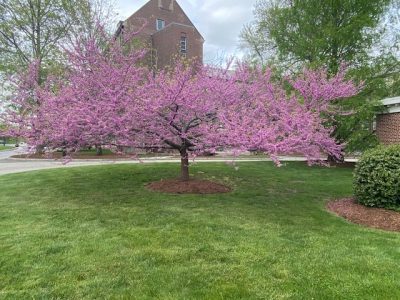
Arbor Day is celebrated in Connecticut on April 25th. Since it is a day traditionally set aside for the planting of trees, perhaps you might consider adding one to your home landscape. If you haven’t the need for another arboreal specimen, then plan on giving your existing trees a little TLC.
Trees have a lot to offer. They provide us with cool shade on hot summer days, brighten our spring season with lovely blossoms, add color to the fall landscape and winter interest throughout cold, dreary days. Trees provide food, nesting sites and shelter for many animals, especially birds. They help reduce noise pollution, trap particulate air pollutants, and can alter the microclimate surrounding them.
Most importantly, trees supply plenty of oxygen for us to breathe. Each year, an acre of trees produces enough oxygen to keep 18 people alive. They also sequester carbon dioxide. Trees convert atmospheric carbon dioxide into plant matter as they photosynthesize. This has important consequences worldwide. As more and more of our forested land is being cleared, less carbon dioxide can be stored in trees and more is available to increase the atmospheric carbon dioxide levels which, in turn, can contribute to global warming.
While we can’t stop global deforestation, we can make a difference in our own backyards by planting more trees or making sure that the trees already present receive the conditions they need to thrive.
When selecting a tree for your landscape, do consider factors like its ultimate height and spread, susceptibility to insect and disease problems, flowering, fruiting and fall foliage potential, rate of growth and site requirements. Review gardening books, consult with nurserymen and maybe visit an arboretum to view mature specimens.
Trees are purchased either as dormant stock through mail order sources, containerized, or balled-and-burlapped (B & B). Dormant trees generally arrive in the spring or fall and should be soaked for a couple of hours and planted immediately. If you can’t get them in the ground right away, they can be stored in a cool place for a few days out of direct sunlight. Make sure them are kept moist.
Containerized stock can be planted throughout the growing season although cooler spring or fall is best. Hard to transplant species are best purchased this way as there is less disruption to their root system. If potbound, make several vertical cuts about one-quarter inch deep around the root ball before planting.
Purchasing B & B trees is fine for younger specimens, but often larger trees have a good portion of their roots removed in this process. This can lead to poor survival. For greatest success, choose small to medium sized trees.
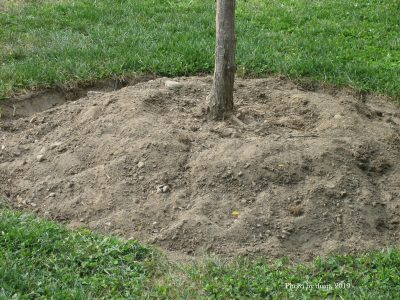
Holes for planting only need be as deep as the root system. The key is to make them at least 2 feet wider than the root ball. Especially in heavy or compacted soils, be sure to
loosen as much soil around the planting area as possible so roots can grow freely. The majority of roots are found in the upper 3 feet of soil.
Amendments such as peat moss or fertilizer are not necessary to add to the backfill. However, if the soil pH or phosphorus levels are low, ground limestone and bonemeal can be mixed into the backfill.
Add water to the hole before planting and let it drain. Next, position the root ball. Remove plastic mesh and cords. Burlap can be cut away as much as possible. Fill in the hole about half way. Gently firm the soil around the root ball. Don’t stomp on it or you will compact the soil. Water thoroughly and when the water drains, finish filling the hole. Make a well around the tree with soil and water once more. Apply a 2 to 3 inch layer of mulch keeping it away from the trunk. Newly planted trees need a thorough soaking each week throughout the first growing season either from natural precipitation or from you.
If you have questions about trees or any other gardening topic, call the UCONN Home & Garden Education Center (toll-free) at (877) 486-6271 or email us at ladybug@uconn.edu or visit our website, www.homegarden.cahnr.uconn.edu.
This article was published in the Hartford Courant Apr. 26 2025
Calling the Cut – Tree Triage, Care, and Removal
By Nick Goltz, DPM, UConn Plant Diagnostic Lab/UConn Home & Garden Education Center
The forecast is looking good for a perfect 4th of July weekend. Most folks will take advantage of the weather ahead to plan that perfect grilling menu for when their friends and family visit. This is a much-needed respite from the severe weather that passed through over the past few weeks. Severe winds and torrential rains hammered Connecticut and most of the rest of the Northeast after a recent heat wave. With the weather for the week ahead of us is looking much better than the weather of the week behind us, now is the perfect time to assess our trees and determine if any action needs to be taken before the next storm comes!
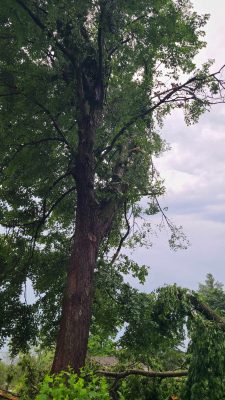
I’ll start and end this column with the advice that a professional arborist should be called-in if you are ever unsure of your tree’s health, or if you need support regarding safe management and potential removal. In Connecticut, one of the best resources for finding a licensed, local arborist as well as additional resources regarding tree care and maintenance can be found on the Connecticut Tree Protective Association website, ctpa.org. That said, tree triage can start with you at home. There are many things one can be on the lookout for to determine if a tree need professional attention, and potentially in what order the work should be done.
I’m sure you’ve heard this phrase used to describe real estate, but with trees too, location is everything. The first thing to consider when performing your tree triage is the location of the tree. Regardless of tree age, size, species, or health, the trees that should always merit our immediate attention are those in locations where they could pose a danger to life or property if a limb were to fall off or if the tree were to topple altogether. Trees within striking distance of homes, power lines, and important structures like chicken coops and pet houses should always be the first inspected before the storm comes and after it passes. If a tree knocks down a power line or hits a home, call for help. Never attempt to work around a live cable (one that still carries electricity) without the proper training and equipment.
The second thing to consider as you perform your tree triage is health of the tree. Trees weakened by disease or age are more likely to succumb to strong winds or topple after standing water weakens or kills roots. Inspect your trees for symptoms of stress and disease such as branches that no longer produce leaves. Depending on the species of tree, a few may not be much cause for concern, but if there are several branches on a tree that no longer produce new leaves or needles, the tree is likely not in great health. Another symptom of stress or disease is a visible canker, or large wound, on the trunk of the tree. Trees in good health will typically grow new tissue over an injury sustained by pruning, animal feeding, or a previous storm. Cankers that appear to be getting larger over a few years, rather than smaller, are often a cause for concern.
There are even some obvious signs of disease such as conk or shelf mushrooms that grow directly from the wood of the tree. While these organisms are important for nutrient cycling in natural ecosystems, they often indicate that a tree is approaching the end of its life. The shelf mushroom is only the sexual structure of the fungus, there to produce spores and reach new trees. While removing the mushroom may slow the spread of the fungus to other trees nearby, the majority of the “body” of the fungus will still exist within the tree, weakening it by breaking down woody tissue over time.
Trees, like other living things, do not live indefinitely and become more vulnerable to illness and stress as they age. Just like people need to take care of themselves to ensure they live a long, healthy life, so too must trees be cared for over the course of their lives to ensure they have the best possible outcome. Regular fertilization and pruning are essential to not only ensure that a tree grows robustly, but also that it does not become lopsided or heavy on one side as it ages. Even healthy trees can fall if they are never pruned and have a poor center of gravity! Pruning should be performed frequently to promote new growth, discourage lopsidedness, and allow increased airflow through the canopy. This will have the double benefit of decreasing disease pressure that often accompanies high canopy humidity and prolonged leaf wetness. Though it depends on the species of tree, most here in New England perform best when pruned while they are dormant in winter. Remember to not remove more than 1/3 of the tree’s branches when pruning, if possible!
There are other factors to consider when determining if a tree should come down that we don’t have space to discuss at length here, such as the species of tree, whether the tree is used for other purposes (such as part of a living fence), whether the tree has historic or personal significance, or what removal of the tree may mean for other plants nearby that depend on its shade. And, of course, nobody should consider tree removal without considering cost and time. If cost is a concern, remember to do your triage and prioritize the management of trees that could potentially damage your home, property, or power lines if they were to fall. These considerations and others are worth discussing with an arborist as they survey your property!
For questions about planting and pruning trees or other gardening topics, feel free to contact us, toll-free, at the UConn Home & Garden Education Center at (877) 486-6271, visit our website at www.homegarden.cahnr.uconn.edu or contact your local Cooperative Extension Center.
Remove Those Suckers!
By Dawn Pettinelli, UConn Home & Garden Education Center
About now the gardens should be planted, and it is time to turn our attention to the trees and shrubs on the property. New growth is almost fully expanded and pruning of spring flowering shrubs can commence. When out there with your pruners, keep an eye peeled for suckers and water sprouts, both on the plants you’re pruning and other woody plants in the yard.
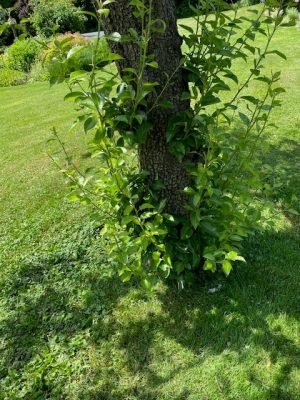
Many trees and shrubs produce vigorous, upright stems that can reach several feet high over the growing season if left unchecked. Those arising from the root system are known as suckers while those growths arising from the crown portion of a tree or large shrub are referred to as water sprouts. At the very least, they are unattractive and take away from the architectural framework of a plant. More importantly they use water, nutrients and energy that could be put to better use if not taken from the rest of the plant. If not removed, they can crowd out the main plant resulting in reduced vigor.
Some woody plants naturally tend to produce suckers and sometimes these young vigorous shoots are needed to rejuvenate older plants as aging stems are removed. An example would be shrubs like red-twigged dogwoods or lilacs. Suckers arising from trees such as apples, crabapples, honey locust, lindens and others, however, should be removed.
In the case of grafted plants, like hybrid tea roses or apples, the desired variety is grafted on to a rootstock that might be more cold hardy, have dwarfing genes or other desired features. Occasionally the rootstock revolts, so to speak, and sends up its own shoots. In the case of roses, one might notice a stem with red flowers when the plant was purchased as a named cultivar with different colored flowers.
Suckers and water sprouts often occur because plants are in some way stressed or due to damage to their root system. Plants can be under stress for a number of reasons. Some common reasons would be insect or disease problems, drought, too high of a water table, compacted soil and/or difficult growing conditions.
Planting too deep will also stress a plant and could cause suckers to develop. Whenever planting woody plants sink them so that the level of soil in the pot they are grown in is level with the soil they are planted in.
Another reason for suckers or water sprouts is that plants are pruned incorrectly or too drastically. Seldom is it advisable to remove more than one-third of the plant at one time. Also, avoid topping ornamental or woodland trees.
Ideally suckers and water sprouts should be removed as soon as they are produced. Often, they can just be rubbed or twisted off in spring as their stem is just starting to expand. Once they reach pencil-size in thickness, cut with clean, sharp pruners. Do your best to remove them flush to a limb or as close to the tree’s trunk or root system as you can. Don’t leave stubs as these will likely have buds at their base and just regrow.
Speaking of suckers, there are often questions when growing tomatoes about what to do with the sprouts popping up where the leaf attaches to the main stem. Typically suckers just form on indeterminate tomato varieties, which are those that continue to grow, bloom and set fruit as long as growing conditions allow. If all suckers are left on the plant, it becomes quite unruly and hard to stake. Also, fruit will be plentiful but usually smaller.
Usually, the suckers below the first fruiting cluster are removed so the development of those tomatoes won’t be slowed. Then it is up to individual gardeners to decide whether to leave suckers or not and how many to leave. Often a few are left to increase and extend the harvest. Tomatoes in our area are prone to many leaf diseases, especially during humid and wet seasons. As the bottom leaves yellow and die, it is beneficial to let some of the suckers on top grow so plants can produce more foliage to yield food for the plant and to shade the developing fruit. Some experimentation might be necessary keeping in mind that it is better to remove too little than too much.
For questions about pruning suckers and water sprouts or on other gardening topics, feel free to contact us, toll-free, at the UConn Home & Garden Education Center at (877) 486-6271, visit our website at www.homegarden.cahnr.uconn.edu or contact your local Cooperative Extension Center.